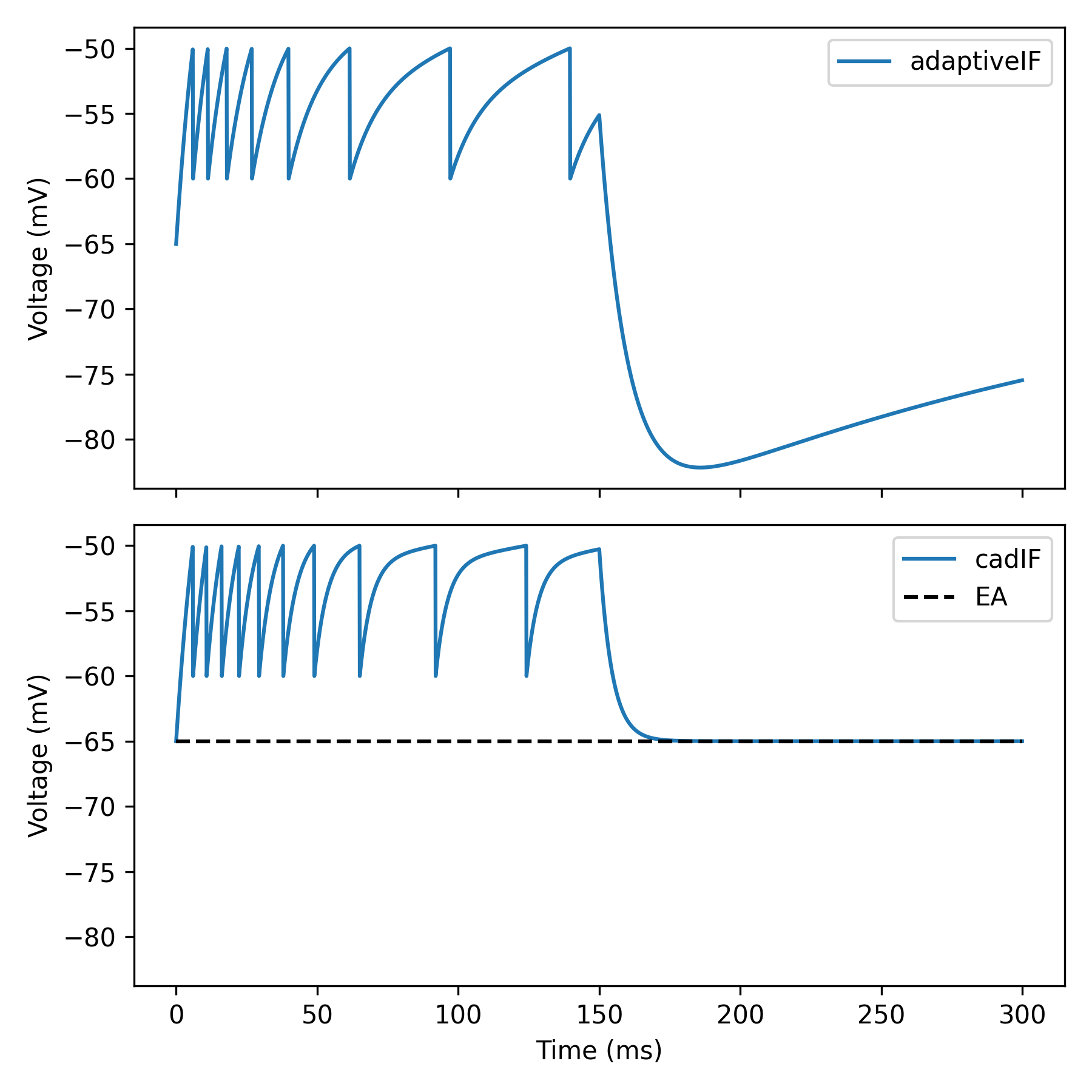Other adaptive models#
Apart from the Adaptive Exponential integrate-and-fire model (AdEx), Dendrify also supports other types of adaptive models, that can be preferred in some cases. In this example, we compare the behavior of two different adaptive models:
The Adaptive IF model with current-based adaptation (adaptiveIF), which is simpler and faster to simulate than AdEx.
The Conductance-based adaptive IF model (cadIF), which provides a solution to a common problem of current-based models, namely the excessive membrane hyperpolarization that can occur after high-frequency firing.
import brian2 as b
from brian2.units import Hz, ms, mV, nA, nS, pA, pF
from dendrify import PointNeuronModel
b.prefs.codegen.target = 'numpy' # faster for simple simulations
# A point neuron model with current-based adaptation
adaptiveIF = PointNeuronModel(
model='adaptiveIF',
cm_abs=150*pF,
gl_abs=15*nS,
v_rest=-65*mV)
adaptiveIF.add_params(
{'Vth': -50*mV,
'tauw': 210*ms,
'a': 0*nS, # no subthreshold adaptation for simplicity
'b': 60*pA,
'Vr': -60*mV})
adaptiveIF_neuron = adaptiveIF.make_neurongroup(
N=1,
threshold='V>Vth',
reset='V=Vr; w+=b',
method='euler')
# A point neuron model with conductance-based adaptation
cadIF = PointNeuronModel(
model='cadIF',
cm_abs=150*pF,
gl_abs=15*nS,
v_rest=-65*mV)
cadIF.add_params(
{'Vth': -50*mV,
'tauA': 210*ms,
'gAmax': 0*nS, # no subthreshold adaptation for simplicity
'delta_gA': 3*nS,
'Vr': -60*mV,
'EA': -65*mV})
cadIF_neuron = cadIF.make_neurongroup(
N=1,
threshold='V>Vth',
reset='V=Vr; gA+=delta_gA',
method='euler')
# Record voltages
adaptiveIF_trace = b.StateMonitor(adaptiveIF_neuron, ['V'], record=0)
cadIF_trace = b.StateMonitor(cadIF_neuron, ['V'], record=0)
# Run simulation
adaptiveIF_neuron.I_ext = 500*pA
cadIF_neuron.I_ext = 500*pA
b.run(150 * ms)
adaptiveIF_neuron.I_ext = 0*pA
cadIF_neuron.I_ext = 0*pA
b.run(150 * ms)
# Plot results
fig, axes = b.subplots(2, 1, figsize=[6, 6], sharex=True, sharey=True)
ax1, ax2 = axes
ax1.plot(adaptiveIF_trace.t / ms,
adaptiveIF_trace[0].V / mV,
label='adaptiveIF')
ax1.set_ylabel('Voltage (mV)')
ax1.legend()
ax2.plot(cadIF_trace.t / ms,
cadIF_trace[0].V / mV,
label='cadIF')
ax2.hlines(-65, 0, 300, 'k', '--', label='EA')
ax2.set_xlabel('Time (ms)')
ax2.set_ylabel('Voltage (mV)')
ax2.legend()
fig.tight_layout()
b.show()
